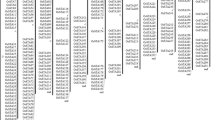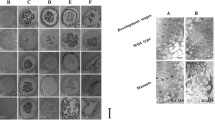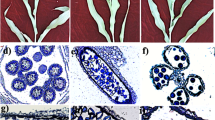Abstract
To further understand the regulatory mechanism for anther dehiscence in rice, we carried out transcriptome analysis for the following two tissues: the anther wall and pollen at the anthesis stage. With the anatomical meta-expression data, in addition to these tissues, the differentially expressed genes (DEGs) between the two tissues were further refined to identify 1,717 pollen-preferred genes and 534 anther wall-preferred genes. A GUS transgenic line and RT-qPCR analysis for anther wall-preferred genes supported the fidelity of our gene candidates for further analysis. The refined DEGs were functionally classified through Gene Ontology (GO) enrichment and MapMan analyses. Through the analysis of cis-acting elements and alternative splicing variants, we also suggest the feature of regulatory sequences in promoter regions for anther wall-preferred expression and provide information of the unique splicing variants in anther wall. Subsequently, it was found that hormone signaling and the resulting transcriptional regulation pathways may play an important role in anther dehiscence and anther wall development. Our results could provide useful insights into future research to broaden the molecular mechanism of anther dehiscence or anther wall development in rice.







modified from KEGG (Fig. S1). Lipid metabolism control by alternative splicing might also be associated with this process
Similar content being viewed by others
References
Bailey TL, Boden M, Buske FA et al (2009) MEME SUITE: tools for motif discovery and searching. Nucleic Acids Res 37:W202-208. https://doi.org/10.1093/nar/gkp335
Cecchetti V, Altamura MM, Brunetti P et al (2013) Auxin controls Arabidopsis anther dehiscence by regulating endothecium lignification and jasmonic acid biosynthesis. Plant J 74:411–422. https://doi.org/10.1111/tpj.12130
Chandran AKN, Hong W-J, Abhijith B et al (2020) Rice male gamete expression database (RMEDB): a web resource for functional genomic studies of rice male organ development. J Plant Biol 63:421–430. https://doi.org/10.1007/s12374-020-09267-1
De Storme N, Geelen D (2014) The impact of environmental stress on male reproductive development in plants: biological processes and molecular mechanisms. Plant Cell Environ 37:1–18. https://doi.org/10.1111/pce.12142
Guo H, Li L, Ye H et al (2009) Three related receptor-like kinases are required for optimal cell elongation in Arabidopsis thaliana. PNAS 106:7648–7653. https://doi.org/10.1073/pnas.0812346106
Gupta S, Stamatoyannopoulos JA, Bailey TL, Noble WS (2007) Quantifying similarity between motifs. Genome Biol 8:R24. https://doi.org/10.1186/gb-2007-8-2-r24
Han M, Kim C-Y, Lee J et al (2014) OsWRKY42 represses OsMT1d and induces reactive oxygen species and leaf senescence in rice. Mol Cells 37:532–539. https://doi.org/10.14348/molcells.2014.0128
Hong W-J, Kim Y-J, Kim E-J et al (2020) CAFRI-rice: CRISPR applicable functional redundancy inspector to accelerate functional genomics in rice. Plant J 104:532–545. https://doi.org/10.1111/tpj.14926
Hwang JE, Hwang S-G, Jung IJ et al (2020) Overexpression of rice F-box protein OsFBX322 confers increased sensitivity to gamma irradiation in Arabidopsis. Genet Mol Biol 43:e20180273. https://doi.org/10.1590/1678-4685-GMB-2018-0273
Ishiguro S, Kawai-Oda A, Ueda J, Nishida I, Okada K (2001) The DEFECTIVE IN ANTHER DEHISCENCE1 gene encodes a novel phospholipase A1 catalyzing the initial step of jasmonic acid biosynthesis, which synchronizes pollen maturation, anther dehiscence, and flower opening in Arabidopsis. Plant Cell 13:2191–2209. https://doi.org/10.1105/tpc.010192
Jagadish SVK, Muthurajan R, Oane R et al (2010) Physiological and proteomic approaches to address heat tolerance during anthesis in rice (Oryza sativa L.). J Exp Bot 61:143–156. https://doi.org/10.1093/jxb/erp289
Jeon JS, Lee S, Jung KH et al (2000) T-DNA insertional mutagenesis for functional genomics in rice. Plant J 22:561–570. https://doi.org/10.1046/j.1365-313x.2000.00767.x
Jung K, Oh S-I, Kim Y et al (2008) Arabidopsis histidine-containing phosphotransfer factor 4 (AHP4) negatively regulates secondary wall thickening of theanther endothecium during flowering. Mol Cells 25:294–300
Jung SE, Bang SW, Kim SH et al (2021) Overexpression of OsERF83, a vascular tissue-specific transcription factor gene, confers drought tolerance in rice. Int J Mol Sci 22:7656. https://doi.org/10.3390/ijms22147656
Kim D, Paggi JM, Park C et al (2019) Graph-based genome alignment and genotyping with HISAT2 and HISAT-genotype. Nat Biotechnol 37:907–915. https://doi.org/10.1038/s41587-019-0201-4
Lata C, Prasad M (2011) Role of DREBs in regulation of abiotic stress responses in plants. J Exp Bot 62:4731–4748. https://doi.org/10.1093/jxb/err210
Liao Y, Smyth GK, Shi W (2014) featureCounts: an efficient general purpose program for assigning sequence reads to genomic features. Bioinformatics 30:923–930. https://doi.org/10.1093/bioinformatics/btt656
Lin H, Yu J, Pearce SP et al (2017) RiceAntherNet: a gene co-expression network for identifying anther and pollen development genes. Plant J 92:1076–1091. https://doi.org/10.1111/tpj.13744
Love MI, Huber W, Anders S (2014) Moderated estimation of fold change and dispersion for RNA-seq data with DESeq2. Genome Biol 15:1–21. https://doi.org/10.1186/s13059-014-0550-8
Martin M (2011) Cutadapt removes adapter sequences from high-throughput sequencing reads. Embnet J 17:10–12. https://doi.org/10.14806/ej.17.1.200
Moon S, Chandran A, Kim Y-J et al (2019) Rice RHC encoding a putative cellulase is essential for normal root hair elongation. J Plant Biol 62:82–91. https://doi.org/10.1007/s12374-018-0393-z
Moon S, Hong W-J, Kim Y-J et al (2020) Comparative transcriptome analysis reveals gene regulatory mechanism of UDT1 on anther development. J Plant Biol 63:289–296. https://doi.org/10.1007/s12374-020-09250-w
Morgante CV, Guimarães PM, Martins AC et al (2011) Reference genes for quantitative reverse transcription-polymerase chain reaction expression studies in wild and cultivated peanut. BMC Res Notes 4:339. https://doi.org/10.1186/1756-0500-4-339
Muthayya S, Sugimoto JD, Montgomery S, Maberly GF (2014) An overview of global rice production, supply, trade, and consumption: Global rice production, consumption, and trade. Ann NY Acad Sci 1324:7–14. https://doi.org/10.1111/nyas.12540
Obata T, Kitamoto HK, Nakamura A et al (2007) Rice shaker potassium channel OsKAT1 confers tolerance to salinity stress on yeast and rice cells. Plant Physiol 144:1978–1985. https://doi.org/10.1104/pp.107.101154
Pfaffl MW (2001) A new mathematical model for relative quantification in real-time RT-PCR. Nucleic Acids Res 29:e45. https://doi.org/10.1093/nar/29.9.e45
Qiao D, Yang C, Chen J et al (2019) Comprehensive identification of the full-length transcripts and alternative splicing related to the secondary metabolism pathways in the tea plant (Camellia sinensis). Sci Rep 9:2709. https://doi.org/10.1038/s41598-019-39286-z
Quinet M, Ndayiragije A, Lefèvre I et al (2010) Putrescine differently influences the effect of salt stress on polyamine metabolism and ethylene synthesis in rice cultivars differing in salt resistance. J Exp Bot 61:2719–2733. https://doi.org/10.1093/jxb/erq118
Rieu I, Wolters-Arts M, Derksen J et al (2003) Ethylene regulates the timing of anther dehiscence in tobacco. Planta 217:131–137. https://doi.org/10.1007/s00425-003-0976-9
Sakata T, Higashitani A (2008) Male sterility accompanied with abnormal anther development in plants—genes and environmental stresses with special reference to high temperature injury. Int J Plant Dev Biol 2:2
Schmidt R, Schippers JHM, Mieulet D et al (2014) SALT-RESPONSIVE ERF1 is a negative regulator of grain filling and gibberellin-mediated seedling establishment in rice. Mol Plant 7:404–421. https://doi.org/10.1093/mp/sst131
Sharma R, Agarwal P, Ray S et al (2012) Expression dynamics of metabolic and regulatory components across stages of panicle and seed development in indica rice. Funct Integr Genomics 12:229–248. https://doi.org/10.1007/s10142-012-0274-3
Shen S, Park JW, Huang J et al (2012) MATS: a Bayesian framework for flexible detection of differential alternative splicing from RNA-Seq data. Nucleic Acids Res 40:e61–e61. https://doi.org/10.1093/nar/gkr1291
Shi J, Tan H, Yu X-H et al (2011a) Defective pollen wall is required for anther and microspore development in rice and encodes a fatty acyl carrier protein reductase. Plant Cell 23:2225–2246. https://doi.org/10.1105/tpc.111.087528
Skalak J, Nicolas KL, Vankova R, Hejatko J (2021) Signal integration in plant abiotic stress responses via multistep phosphorelay signaling. Front Plant Sci 12:196. https://doi.org/10.3389/fpls.2021.644823
Song S, Chen Y, Liu L et al (2018) OsFTIP7 determines auxin-mediated anther dehiscence in rice. Nature Plants 4:495–504. https://doi.org/10.1038/s41477-018-0175-0
Steiner-Lange S, Unte US, Eckstein L et al (2003) Disruption of Arabidopsis thaliana MYB26 results in male sterility due to non-dehiscent anthers. Plant J 34:519–528. https://doi.org/10.1046/j.1365-313X.2003.01745.x
Steinhorst L, Kudla J (2013) Calcium-a central regulator of pollen germination and tube growth. Biochim Biophys Acta Mol Cell Res 1833:1573–1581. https://doi.org/10.1016/j.bbamcr.2012.10.009
Tanaka N, Uraguchi S, Saito A et al (2013) Roles of pollen-specific boron efflux transporter, OsBOR4, in the rice fertilization process. Plant Cell Physiol 54:2011–2019. https://doi.org/10.1093/pcp/pct136
Tibshirani R, Walther G, Hastie T (2001) Estimating the number of clusters in a data set via the gap statistic. J R Stat Soc Ser B (stat Methodol) 63:411–423. https://doi.org/10.1111/1467-9868.00293
Vo KTX, Kim C-Y, Chandran AKN et al (2015) Molecular insights into the function of ankyrin proteins in plants. J Plant Biol 58:271–284. https://doi.org/10.1007/s12374-015-0228-0
Wan X, Wu S, Li Z et al (2020) Lipid metabolism: critical roles in male fertility and other aspects of reproductive development in plants. Mol Plant 13:955–983. https://doi.org/10.1016/j.molp.2020.05.009
Wang Y, Kumar PP (2007) Characterization of two ethylene receptors PhERS1 and PhETR2 from petunia: PhETR2 regulates timing of anther dehiscence. J Exp Bot 58:533–544
Wang Q, Guan Y, Wu Y et al (2008) Overexpression of a rice OsDREB1F gene increases salt, drought, and low temperature tolerance in both Arabidopsis and rice. Plant Mol Biol 67:589–602. https://doi.org/10.1007/s11103-008-9340-6
Wang H, Chan TW, Vashisht AA, Drew BG, Calkin AC, Harris TE, Wohlschlegel JA, Xiao X, Reue K (2021) Lipin 1 modulates mRNA splicing during fasting adaptation in liver. JCI Insight. https://doi.org/10.1172/jci.insight.150114
Wilson ZA, Song J, Taylor B, Yang C (2011) The final split: the regulation of anther dehiscence. J Exp Bot 62:1633–1649. https://doi.org/10.1093/jxb/err014
Xiao Y, Chen Y, Charnikhova T, Mulder PP, Heijmans J, Hoogenboom A, Agalou A, Michel C, Morel J, Dreni L (2014) OsJAR1 is required for JA-regulated floret opening and anther dehiscence in rice. Plant Mol Biol 86:19–33. https://doi.org/10.1007/s11103-014-0212-y
Xie Z, Nolan TM, Jiang H, Yin Y (2019) AP2/ERF transcription factor regulatory networks in hormone and abiotic stress responses in arabidopsis. Front Plant Sci 10:228. https://doi.org/10.3389/fpls.2019.00228
Xu Y, Liu S, Liu Y et al (2017) HOTHEAD-like HTH1 is involved in anther cutin biosynthesis and is required for pollen fertility in rice. Plant Cell Physiol 58:1238–1248. https://doi.org/10.1093/pcp/pcx063
Xu X-F, Wang B, Feng Y-F et al (2019) AUXIN RESPONSE FACTOR17 directly regulates MYB108 for anther dehiscence. Plant Physiol 181:645–655. https://doi.org/10.1104/pp.19.00576
Yao W, Li G, Yu Y, Ouyang Y (2018) funRiceGenes dataset for comprehensive understanding and application of rice functional genes. GigaScience. https://doi.org/10.1093/gigascience/gix119
Zhang D-S, Liang W-Q, Yuan Z et al (2008) Tapetum degeneration retardation is critical for aliphatic metabolism and gene regulation during rice pollen development. Mol Plant 1:599–610. https://doi.org/10.1093/mp/ssn028
Zhang S, Shi Y, Shan C et al (2020) Analysis of the transcriptome of Polygonatum odoratum (Mill.) druce uncovers putative genes involved in isoflavonoid biosynthesis. J Plant Biol 63:217–228. https://doi.org/10.1007/s12374-020-09246-6
Zheng S, Li J, Ma L, Wang H, Zhou H, Ni E, Jiang D, Liu Z, Zhuang C (2019a) OsAGO2 controls ROS production and the initiation of tapetal PCD by epigenetically regulating OsHXK1 expression in rice anthers. Proc Natl Acad Sci U S A 116:7549–7558. https://doi.org/10.1073/pnas.1817675116
Zheng L, Nagpal P, Villarino G et al (2019b) miR167 limits anther growth to potentiate anther dehiscence. Development 146:174375. https://doi.org/10.1242/dev.174375
Zinn KE, Tunc-Ozdemir M, Harper JF (2010) Temperature stress and plant sexual reproduction: uncovering the weakest links. J Exp Bot 61:1959–1968. https://doi.org/10.1093/jxb/erq053
Zwack PJ, Rashotte AM (2015) Interactions between cytokinin signalling and abiotic stress responses. J Exp Bot 66:4863–4871. https://doi.org/10.1093/jxb/erv172
Funding
This work was supported by grants from the New Breeding Technologies Development Program (PJ01492703 to K.-H.J.), the Rural Development Administration, Republic of Korea, and the National Research Foundation (NRF), Ministry of Education, Science and Technology (NRF-2021M3E5E6025387 to K.-H.J.; NRF-2021R1C1C2091377 to W.-J.H.).
Author information
Authors and Affiliations
Contributions
SM, YJK, and KHJ designed this work; WJH, SKL, SHK, EJK, and JS performed the experiments; WJH, SKL, and SHK analyzed the data; SKL, SHK, and YJK generated the figures and tables; WJH, SKL, SHK, and KHJ wrote the manuscript. All authors have read and agreed to publish the manuscript.
Corresponding author
Ethics declarations
Conflict of interest
The authors declare that they have no competing interests for this research.
Additional information
Communicated by Da-Bing Zhang.
Publisher's Note
Springer Nature remains neutral with regard to jurisdictional claims in published maps and institutional affiliations.
Supplementary Information
Below is the link to the electronic supplementary material.
Rights and permissions
About this article
Cite this article
Hong, WJ., Lee, S.K., Kim, SH. et al. Comparative transcriptome analysis of pollen and anther wall reveals novel insights into the regulatory mechanisms underlying anther wall development and its dehiscence in rice. Plant Cell Rep 41, 1229–1242 (2022). https://doi.org/10.1007/s00299-022-02852-3
Received:
Accepted:
Published:
Issue Date:
DOI: https://doi.org/10.1007/s00299-022-02852-3




